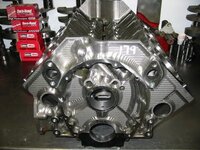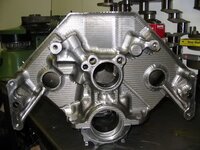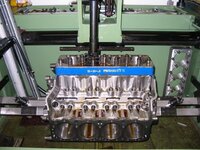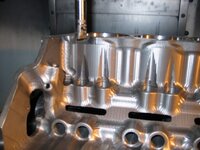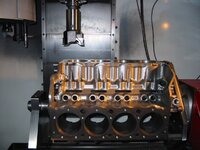You are using an out of date browser. It may not display this or other websites correctly.
You should upgrade or use an alternative browser.
You should upgrade or use an alternative browser.
Extreme block lightening anyone?
- Thread starter big2bird
- Start date
Twin_Turbo
Der Maulwurf
- Joined
- Mar 5, 2008
- Messages
- 7,579
That's a lightened cast block. You see lightened blocks (aluminium_ used in dirt tracking all the time but man, this is a piece of art. I initially thought I was looking at a billet block but the water passages were a giveaway.
http://www.cnblocks.com/
Those are billet blocks, also extremely ooooohhh....aaaahhhh (and watercooled although I suspect the jackets are pretty small)
Didn't Dart machine have a vid online somewhere showing this kind of extreme bilelt block machining?
http://www.cnblocks.com/
Those are billet blocks, also extremely ooooohhh....aaaahhhh (and watercooled although I suspect the jackets are pretty small)
Didn't Dart machine have a vid online somewhere showing this kind of extreme bilelt block machining?
grumpyvette
Well-known member
to me that appears to be both very expensive machine work and counter productive to maximum block strength, lets say youve already invested in an aluminum block, and you can remove 30 lbs from the block like it states,the ALUMINUM SBC block weighs about 120 lbs if you remove 25% of the aluminum you can,t help but reduce its rigidity and strenght and for what?
in a 2800 lb race car your talking about a 1% differance in car weight at most for several thousand dollars MINIMUM, Id bet theres other areas where the weight could be removed with less chance of putting the drive train durability at risk
in a 2800 lb race car your talking about a 1% differance in car weight at most for several thousand dollars MINIMUM, Id bet theres other areas where the weight could be removed with less chance of putting the drive train durability at risk
Twin_Turbo
Der Maulwurf
- Joined
- Mar 5, 2008
- Messages
- 7,579
I'm sure they did a lot of research to see where metal can be removed? And removing metal not always/necessarily makes a part weaker.
I'm sure those who have the $ to spend on that kind of machining, well..they probably have domne all the otehr tricks and this is a last resort.
I'm sure those who have the $ to spend on that kind of machining, well..they probably have domne all the otehr tricks and this is a last resort.
redvetracr
Well-known member
to me that appears to be both very expensive machine work and counter productive to maximum block strength
I believe "lightened" aluminum blocks are used by the winged sprint car guys who race them a few nights and sell them off.....I came across a guy in TX who has a CNC program to do a big block (he claims it cost him $5K JUST for the program), I think I remember him saying it was $1200 to take off about 10# (not enough reduction for me)....plus shipping of course...Dart only does small blocks, LSM is super expensive on most everything they sell so one can assume lightening a block is also expensive, I figured by the time you buy an aftermarket block and get it lightened you might as well start with an aluminum aftermarket block.....
TimAT
Addict, Cruise-In Bird-Run 1 Veteran
In the stuff I've looked at (BB) a Dart block is around $2900, then add that $1200, that's up to $4100- you can get an aluminum block for that money and start out where you'd end up.
redvetracr
Well-known member
actually an aluminum big block is a whole lot lighter than taking 10lbs off a cast iron big block.....besides the $25Kplus for a new motor my only (other) concern would be if an aluminum block can make as much power as a cast block..some say they "move"...
redvetracr
redvetracr
Hello. First post but have been lurking for a little bit. Our lightening programs are carefully designed to remove the majority of material from non structural areas like the water jackets and thick sections that don't carry much load. Bore rigidity remains the same as before. Usually aftermarket block will have loaded lifter valleys to allow multiple lifter patterns to be machined into the same block and we will remove a lot of weight from that area by profiling around the lifters. We can remove 30-35lbs on a small block chevy. 40-45lbs on a big block chevy and over 65lbs on a big block ford.The lightened small blocks were very popular in Nextel Cup cars before the switch to the new blocks. For some racing classes, the lightening is an advantage and we lighten quite a few blocks every year. Blocks will run for at least a full season usually.
We also manufacture billet blocks. We were the first to make a billet LS1 block and a billet 5.300 bore spacing block. Here is a picture of our 5.300 Chevy block.


We use FEA to design each block for high strength and low weight which is why you see ribbing on the blocks that you wont see on any other billet blocks. Multi axis machining with a ball mill takes more time, but leaves fillets at each intersection again for strength. No sharp corners like on a CN block.
At a certain level, by the time you buy an after market block, pay for the machining, then lightening, you may be right around what a billet block costs so it's worth it to use the billet. This stuff is not cheap but at the top level of motorsport, it may be whats needed to win.
Alin
Engineer
LSM Systems Engineering
We also manufacture billet blocks. We were the first to make a billet LS1 block and a billet 5.300 bore spacing block. Here is a picture of our 5.300 Chevy block.


We use FEA to design each block for high strength and low weight which is why you see ribbing on the blocks that you wont see on any other billet blocks. Multi axis machining with a ball mill takes more time, but leaves fillets at each intersection again for strength. No sharp corners like on a CN block.
At a certain level, by the time you buy an after market block, pay for the machining, then lightening, you may be right around what a billet block costs so it's worth it to use the billet. This stuff is not cheap but at the top level of motorsport, it may be whats needed to win.
Alin
Engineer
LSM Systems Engineering
mrvette
Phantom of the Opera
Welcome to the motley crew of the Flying Dutchmen....
looks like your company there it not very motley, rather a tight ship.....
got any samples???:hissyfit:
looks like your company there it not very motley, rather a tight ship.....
got any samples???:hissyfit:
69427
The Artist formerly known as Turbo84
..........................


....................................
Alin
Engineer
LSM Systems Engineering
I've always been curious about the water jackets in a billet block. Is the block just hogged out around the cylinder sleeve OD, except the top and bottom, and then the sleeves are wet?
Just curious.
ps: Beautiful piece!
TimAT
Addict, Cruise-In Bird-Run 1 Veteran
WOW! That block is a thing of beauty!
I saw a Flathead Ford some years ago that was in a dragster- that guy had drilled so many holes in that it looked like Swiss Cheese. No idea how much he took off of it, but as heavy as the originals are, I'd guess he'd got 75-100 pounds in chips.
I saw a Flathead Ford some years ago that was in a dragster- that guy had drilled so many holes in that it looked like Swiss Cheese. No idea how much he took off of it, but as heavy as the originals are, I'd guess he'd got 75-100 pounds in chips.
CNC BLOCKS
Well-known member
redvetracr
Well-known member
Here are some pics of a lightened Dart Little-M block.
what did that lightening job cost and what does it cost to do a cast iron BB? also whats the weight loss of the BB?
..........................


....................................
Alin
Engineer
LSM Systems Engineering
I've always been curious about the water jackets in a billet block. Is the block just hogged out around the cylinder sleeve OD, except the top and bottom, and then the sleeves are wet?
Just curious.
ps: Beautiful piece!
We have several styles of water jacket. For the one you see in this block, we com in from the side and cut water jackets directly into the block and then block them off with plates. The plate actually ties in the side of the cylinder with the block to add back some rigidity. That is why you see bolts in the center and the perimeter of the water plate. The sleeves are dry.
We can also do partial water which is no water jacket but just a series of holes drilled the length of the block. Just gets water to the head, and leaves the block very strong. We have also done what we call a semi-wet, which is a liner with a series of grooves. The liner is fully supported but water can flow through the grooves to cool the cylinder. We try to stay away from wet liners as much as possible.
Carl, I'm curious, where do you mount the starter on that Little M?
Alin
Last edited:
Twin_Turbo
Der Maulwurf
- Joined
- Mar 5, 2008
- Messages
- 7,579
That block is most likely for a brinn or bert style w/ a remote bell mounted starter
CNC BLOCKS
Well-known member
..........................


....................................
Alin
Engineer
LSM Systems Engineering
I've always been curious about the water jackets in a billet block. Is the block just hogged out around the cylinder sleeve OD, except the top and bottom, and then the sleeves are wet?
Just curious.
ps: Beautiful piece!
We have several styles of water jacket. For the one you see in this block, we com in from the side and cut water jackets directly into the block and then block them off with plates. The plate actually ties in the side of the cylinder with the block to add back some rigidity. That is why you see bolts in the center and the perimeter of the water plate. The sleeves are dry.
We can also do partial water which is no water jacket but just a series of holes drilled the length of the block. Just gets water to the head, and leaves the block very strong. We have also done what we call a semi-wet, which is a liner with a series of grooves. The liner is fully supported but water can flow through the grooves to cool the cylinder. We try to stay away from wet liners as much as possible.
Carl, I'm curious, where do you mount the starter on that Little M?
Alin
The custmer runs a Quarter Master bell housing with a reverse mounted starter on the bell housing.

